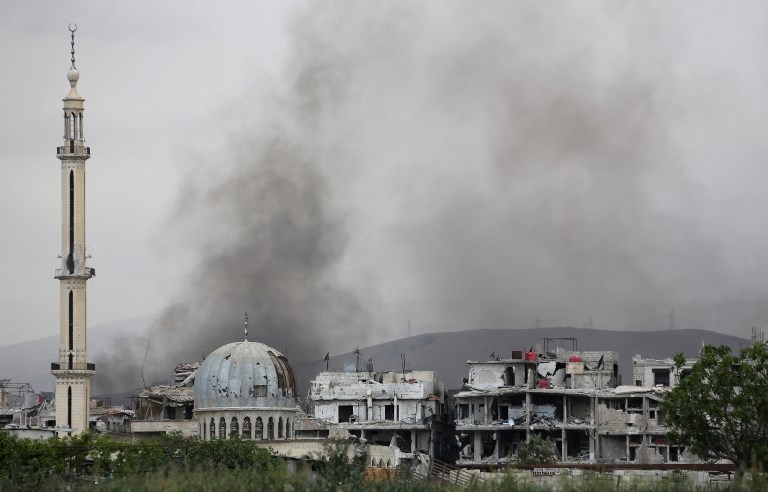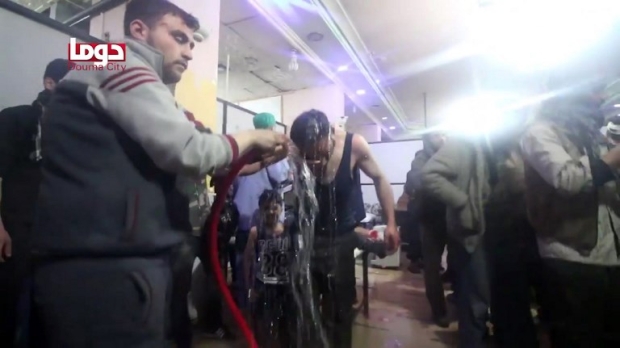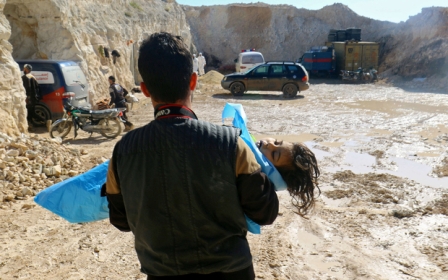Chemical weapons in Syria: The hypocrisy of military action and ‘red lines’

The Syrian crisis has occupied a distinct place since the start of Arab uprisings. Proactive steps by domestic opposition groups had triggered the revolts in Tunisia, Libya and Egypt, which all began with ostensibly apolitical civilian protests that were mostly focused on economic grievances related to the destructive 20th-century status quo.
In Tunisia and Egypt, the geopolitical axis and institutionalised state structures prevented Zine El Abidine Ben Ali and Hosni Mubarak from committing mass atrocities to quell the revolts. In Libya, Muammar Gaddafi used military force against demonstrators without even understanding what he was fighting against, and the country was swiftly plunged into civil war.
Syria was the final link in the chain of Arab uprisings, erupting with a bloody violence incomparable to the others. In the early days of Syria’s 2011 protests, youth wrote messages on the walls stating: "The people want to topple the regime." Thus, the Syrian revolt began with a distinct political context.
A special geopolitical backdrop
It was not only the revolutionaries who were different. Syria’s Baathist rulers took lessons from what happened to other Arab regimes and intervened in the bloodiest way possible, as it had done several times before.
Unlike Syrian President Bashar al-Assad, the dictators in Tunisia, Libya and Egypt had not actually owned their regimes, owing their positions to geopolitical dynamics and domestic power relations. None had inherited power through blood relations, which meant that their dismissal, though still problematic, was not an existential crisis for their respective state establishments.
Assad, however, took over a sectarian dynasty from his father. Complex domestic and regional geopolitical considerations underpinned the establishment of his rule over a minority sect in the country. Syria's relations with Iran and Russia on the one hand, and Israel's existence as a useful excuse on the other, provided the Syrian regime with a special geopolitical backdrop. US-Iranian cooperation after the invasion of Iraq only solidified Syria's position.
The only result of ignoring people’s demand for change is the accumulation of more anger and the reincarnation of terrorism under new names and forms
All of these factors meant one thing: Baathist rule was ready to unleash another bloodbath to survive. Syrian people have been subjected to a 21st-century version of the Rwandan genocide, only in slow motion, enduring seven years of mindless mass killings, missile attacks and the use of chemical weapons.
Bloodbaths, massacres, extrajudicial killings, torture and oppression were already in the organic lexicon of Syrians. In the late 1970s, a tough mood prevailed as the Baathist regime prepared to wage war against opposition: "What was demanded was absolute loyalty: those who were not with the regime must now be considered against it. The Baathist state had to be defended, in blood if necessary. Stalin had sacrificed ten million to preserve Bolshevik revolution and Syria should be prepared to do likewise,” Patrick Seale wrote in Asad: The Struggle for the Middle East.
Trying to recreate Hama
According to a passage in Thomas Friedman’s From Beirut to Jeruasalem, a Lebanese businessman involved in several deals with Syrian general Rifaat Assad once mentioned a conversation they'd had about the Hama rebellion. "I guess you killed 7,000 people there," the businessman said to Rifaat, as cited in Friedman's book. Rather than playing down the scope of the tragedy, Rifaat reportedly responded: "What are you talking about, 7,000? No, no. We killed 38,000."
The Assad regime has spent the last seven years trying to recreate Hama all over Syria.
Obama in 2013 appealed to Congress for military intervention in Syria, only to lose the vote. In reality, Obama gave a green light not only to Assad but also to Sisi by refusing to call the events of 3 July 2013 a coup d'etat.
Sisi's regime was given a green light when he committed a televised massacre, targeting thousands of peaceful protesters in Rabaa Square and other places. Assad and his accomplices clearly saw this green light, given by Obama and the EU through their passive support for the bloody Egyptian regime. The flame of change ignited in 2011 was put out in Egypt two years later, providing a gift to Assad’s regime.
A bloody vision for the future
There is now nothing left but pain in Syria - and there is nothing, other than more suffering, that the enablers and supporters of the Syrian regime can offer Syrians. They have no other vision than to maintain the regime through massacres, creating a Syria without Syrians. They continue to kill, hoping that the millions of Syrian refugees will not return and that the seven million internally displaced Syrians will remain where they are.
Yet, it is a sheer hallucination to imagine that by sacrificing Syrians, they could rid themselves of their deep fear of a change in the regional status quo. The only result of ignoring people’s demand for change is the accumulation of more anger and the reincarnation of terrorism under new names and forms.
The Syrian problem was purposefully, yet mistakenly, not seen as a geopolitical crisis from day one because its resolution would mean a change in the regional status quo. Instead, the Syrian crisis was reduced to a problem of terrorism or chemical weapons. While this resulted in the worst humanitarian tragedy of the 21st century, the geopolitical situation deteriorated further.
A partial military response to the use of chemical weapons by the regime and its supporters in Douma can only continue the sense of deja vu of the last seven years. Only if we approach the Syrian crisis as a geopolitical problem and a human tragedy, will we have a chance to offer a comprehensive solution.
A twisted perspective that fears democratic change more than chemical weapons, or a change in the status quo more than terrorism, is just as hypocritical as Obama's "red line".
- Taha Ozhan is a member of the Turkish parliament and a former chairman of its foreign affairs committee. He is an academic and writer and holds a PhD in politics and international relations. He frequently comments and writes for international media. His latest book is: Turkey and the Crisis of Sykes-Picot Order (2015).
The views expressed in this article belong to the author and do not necessarily reflect the editorial policy of Middle East Eye.
Photo: Smoke billows behind destroyed buildings in the Eastern Ghouta region on the outskirts of Damascus on 10 April 2018 (AFP).
This article is available in French on Middle East Eye French edition.
Middle East Eye propose une couverture et une analyse indépendantes et incomparables du Moyen-Orient, de l’Afrique du Nord et d’autres régions du monde. Pour en savoir plus sur la reprise de ce contenu et les frais qui s’appliquent, veuillez remplir ce formulaire [en anglais]. Pour en savoir plus sur MEE, cliquez ici [en anglais].






